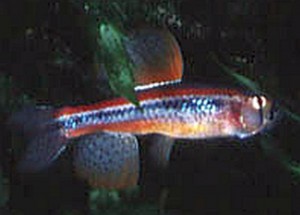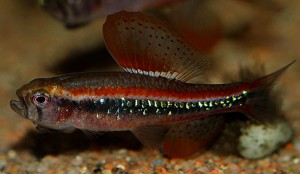The Weitzman Tetra (Poecilocharax weitzmani) is widely distributed throughout several river drainages in Brazil, Colombia, Venezuela, and Peru, and is also known to tropical fish keeping enthusiasts as the Black Darter Tetra or Black morpho tetra. Wild specimens collected from Colombia and Brazil are much more intensely colored, and specimens collected from Peru may be an undescribed species.
Weitzman Tetras are found in very soft, acidic, tannin stained waters that are most commonly found in slow moving rain forest streams with mud or sand substrates, lots of submerged trees, and an abundance of decomposing leaf litter.
These systems are typically in tropical rain forests where the dense jungle canopy provides constant shade, and the release of tannins and organic acids from decomposing plant material stains the water a dark tea color. These conditions occur in the upper regions of the Río Negro, Río Orinoco, including the Río Inírida and Casiquiare canal, and Río Solimões where the fish are commonly collected.
Unlike the majority of Tetras, the Weitzman Tetra does not form into large shoals. Males are territorial and aggressive towards each other, and although it is possible to keep a pair in an aquarium environment, it is better to keep them in a small group or “harem” of one or two males with several females to minimize bullying.
Poecilocharax weitzmani is a small elongated, slender bodied species that resembles a killifish and has the disposition of a dwarf cichlid.
The Weitzman Tetra, or Black Darter Tetra has pale yellow brown body color, with a bold black lateral band with neon blue “portholes” that runs from the gills to the caudal fin.
Mature males are slightly larger than females, considerably more colorful, and have extended dorsal and anal fins that the females lack.
Prior to spawning their colors intensify and the fin tips of the males turn white. Females develop a red anal fin and become darker in appearance. The extended dorsal fins of the males are often spectacular during spawning.
Weitzman Tetras are difficult to maintain and are best kept in a single species biotope tank with a soft, sandy substrate, some driftwood roots and branches to provide cover, some dried leaf litter for to maintain the pH and the addition of floating plants for shade. Oak, Beech, Indian Almond Leaves
or a mixture of all three are suitable for the biotope and are all effective in maintaining the tannin conditions needed.
Aquatic plants such as Microsorum, Taxiphyllum, or Cryptocoryne spp. can also be included. Gentle filtration from an air powered system is all that is required to maintain the stable conditions necessary for these shy fish. They should never be introduced into a new unstable system and will quickly die when maintained in hard water. They will thrive in a biologically mature biotope system with soft, acidic water conditions.
Although Poecilocharax weitzmani is a micropredator, it is not an efficient competitor and although a single species aquarium is recommended for the Black Darter Tetra, they can be housed in community environments with like sized pelagic species such as Axelrodia, Carnegiella, Nannostomus, Otocinculus, Hisonotus spp., and some of the smaller Hyphessobrycon spp, as long as they are the focal species of the tank.
In their natural habitat in the upper rio Negro, they are collected alongside species of Apistogramma, Copella, Hemigrammus, Moenkhausia, Fluviphylax, as well as some unidentified characids and gobiidae.
Weitzman Tetras are rarely bred in an aquarium environment however, it has been accomplished. They require very soft, acidic (pH 4-5) water, with plenty of hiding places such as rock caves, half of a flowerpot, or pieces of PVC pipe for them to lay their eggs.
Condition the fish by feeding them small live foods to bring them into spawning condition. When ready to spawn, the females become darker and the anal fin turns an intense red color. The colors in the males become more intense and the tips of their pelvic fins become thickened and white.
The males will select a cave or multiple caves as his territory and defend it from other males. When the ripe female is ready to spawn, she will swim into the male’s territory where spawning will occur usually within in a couple of days. The female will deposit between 50 and 100 eggs on the roof of the cave which are guarded by the male. The male will not eat until the eggs hatch, which is usually within 4 to 5 days.
The fry are free swimming approximately 2 days after hatching and can be fed newly hatched baby brine shrimp. At this point the males will cease caring for the brood and most breeders remove the fry or the adults into a rearing tank to prevent the parents from eating them.
Because the male does not eat during the brooding stage, it is important to feed him plenty of live food. During the incubation period, it is also not uncommon for males to spawn with other females
The Black morpho tetra is a micropredator that feeds on aquatic insect larvae, crustaceans, worms, and possibly fish fry in their natural habitat.
In an aquarium environment they are somewhat difficult to feed. Live foods are almost mandatory, but most fish can usually be coaxed over time to accept frozen bloodworms. Poecilocharax weitzmani will not eat any food that is not moving. They will accept live Daphnia, Brine shrimp, , chopped bloodworms, grindal worms
, etc. but are notoriously reluctant to eat flakes or freeze dried foods.
Because they are very quiet and subdued, overly active tankmates will cause the fish to hide and not feed. If is essential that live foods are directed towards individual fish during feeding.
Because of their delicate nature, Weitzman Tetras are seldom exported in large numbers. They are usually brought in as a by catch with Cardinal Tetra shipments and often have hollow belly. Newly purchased specimens almost always need to be brought into condition after being imported, as they ship poorly.
All specimens available for purchase will be wild caught and usually demand a premium price. When available for purchase they can be from anywhere from 3/4″ to 1 1/2″ in size.
Minimum Tank Size: 10 gallons
Care Level: Difficult
Temperament: Peaceful, Shy
Aquarium Hardiness: Delicate
Water Conditions: 75-82° F, <5 dGH, pH 3.0-6.5
Max Size: 1 3/4”
Color Form: Brown, Black, Blue
Diet: Carnivore
Compatibility: Single species biotope
Origin: Brazil, Colombia, Venezuela, and Peru
Family: Characidae
Lifespan: 3-5 years
Aquarist Experience Level: Advanced



